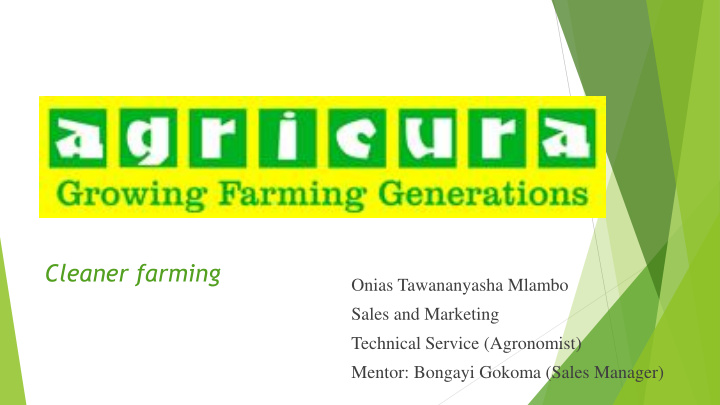



Cleaner farming Onias Tawananyasha Mlambo Sales and Marketing Technical Service (Agronomist) Mentor: Bongayi Gokoma (Sales Manager)
ENHANCING TECHNICAL KNOWLEDGE AND SKILLS TO STAFF MEMBERS.
Overall Objective: Enhancing Organizational Profitability through excellent agronomy services – satisfactory product knowledge, product awareness, end user safety and customer services excellency.
The essential tools: Technical: Provision of technical documents: Quick reference, relevant technical information. Correct technical advice, basis for quotations, alternative products. Dose rates, time of planting, correct use, application method, application time, estimated crop yields, end user safety. Sales and Marketing: Correct technical advice – Effect on brand, staff and product confidence. Environmental and social responsibility. Basis for quotations enables selling. Knowledge of alternative products avoids losing sales Online and media advertising (effective).
Maize Productivity Importance of Maize in Zimbabwe – Staple crop, livestock, beverages, fodder crop. Deep tillage (Conventional) – Primary & Secondary Tillage, Conservation Agriculture. Fertilizers – The 4R’S – Right fertilizer, Right quantity, Right method, Right time. Basal/Base dressing fertilizer – Compound D/Blend - DD Top dressing fertilizer (Split application) – AN/Urea
Maize Productivity Herbicides: Pre – emergent and Post – emergent. Land clearing herbicides – Glyphosate/Roundup, post emergent non selective, systemic herbicide. NO spray on emerged crop! Selective and Non selective herbicides. Contact and Systemic herbicides. Post emergent, selective or non selective herbicides. Post emergent, selective or non selective, contact or systemic herbicides.
Herbicides Factors to be considered on selecting the right herbicide(s): Crop - (Maize, Soya beans, Sugar beans, Cotton, Sorghum, Tobacco) etc. Time of Application – Pre or post – emergent, Selectivity of the herbicides – selective or non selective, stage of weed and crop. Contact or Systemic. Rotations (Issue of Atrazine). Weed spectrum- types of weeds in the field – sedges, shamva grass, couch grass.
Herbicides Factors to be considered on selecting the right herbicide(s): Tank mixtures – Covers a wide weed spectrum, improves effectiveness. Correct dosage - Label specifications, Agricura crop guides, Consult an Agronomist. Use of wetter- rain fastness. Soil type – Clay, sand, sandy loam. Water quality – Ph, water hardiness, clean water. Soil moisture – Affects pre-emergent herbicide activity.
Herbicides Herbicides that can work as both Pre/Post emergent: MCPA 3 – 4ltrs/ha, Atrazine 50SC 3.5-5.5ltrs/ha – For the control of broad leaved weeds only. Pre-emergent herbicides: Mainly grasses and Some Broad leaved weeds – Selective. Acetochlor/Relay/Harness 90EC - 0.75-1ltr/ha. Metolachlor/S-Metolachlor 960EC (Dual Magnum) – 1 – 1.9ltrs/ha. Alachlor 48EC/Laso – 3 – 4ltrs/ha. Pre-emergent herbicides: Mainly Broad leaved weeds – Selective. Terbutryn 50SC – 2 – 4ltrs/Ha Prometryn 3ltrs/Ha.
Herbicides Post – emergent herbicides: Bentazone/Basagran 48EC - 3-5ltrs/ha (Broad leaved weeds and sedges). Accent 75WG/Nicosulfron - 45grms/ha (Shamva grass, certain grasses and just a few broad leaved weeds). Add Agricura wetter. Stellar star - 1ltr/ha (Grasses, Broad leaved weeds, DOES not control sedges, shamva grass, suppresses couch grass). Halosulfron 75WG/Servian - 50grms/ha – Sedges. Dicamba 480SL/Banvel - 300-500mls/ha – Broad leaved weeds only. Paraquat/Gramoxone 1 – 2ltrs/Ha – Non-selective contact herbicide, from tasseling onwards.
Herbicide tank mixtures Pre-emergent herbicides: Grass herbicide + Broad leaved weed herbicide. N.B. Always use the minimum dose rates whenever you are mixing two herbicides – E.g.s S-Metolachlor 1ltr + MCPA 3ltrs/ha S-Metolachlor 1ltr + Atrazine 3.5ltrs/ha Alachlor 3ltrs + Atrazine 3ltrs/ha Alachlor 3ltrs + MCPA 3ltrs/ha Relay 0.75ltrs + Atrazine 3.5ltrs/ha Relay 0.75ltrs + MCPA 3.5ltrs/ha
Herbicide tank mixtures Post-emergent herbicide tank mixtures: Accent 45grms + Atrazine 3.5ltrs/ha Accent 45grms + MCPA 3ltrs/ha Accent 45grms + Dicamba 350mls/ha MCPA 500mls + Metribuzine 150 – 200mls/ha – Post directed spray. Stellar star 0.7ltrs + Atrazine 1ltr/ha – Remember issue of rotations. Accent + Basagran/Bentazone 3ltrs/ha
Insecticides Cutworms – Apply as a band spray at planting. Lambda cyhalothrin, Fenvelerate, Decis forte, Chlopyrifos/Dursban. Termites, Ants, White grubs – Chlorpyrifos or Imidacloprid. African armyworm, Stalk borers – Carbaryl, Lambda cyhalothrin, Decis forte. Fall armyworm, boll worms: Belt , Carbaryl , Runner/Methoxyfenozide, Emamectin benzoate + Lufenuron, Emamectin benzoate + thiamethoxam, Cartap hydrochloride, Karate zeon, Lannate/Methomyl, Acephate/Orthene and Avaunt/Steward. Grain protectants – Actellic gold dust, Shumba super max, Fumigation tablets.
Basic Agronomic Calculations: 1 hectare i.e. 100m * 100m = 10 000 square metres = 2.47acres. Volume of water to be used per hectare = 200 – 250 litres per hectare (Herbicides) Volume of water to be used per hectare = 200 – 500 litres per hectare (Insecticides, Fungicides), depending on quite a number of factors. Normally agrochemicals application rates are expressed per 100 litres of water yet small scale farmers are mostly interested on dose rates per 15/16 litres of water – Knapsack hence the need to calculate. Normally we need 12.5 * 16lt knapsack per hectare or 14 * 15lt knapsack per hectare.
Thank you so much!!!
Recommend
More recommend